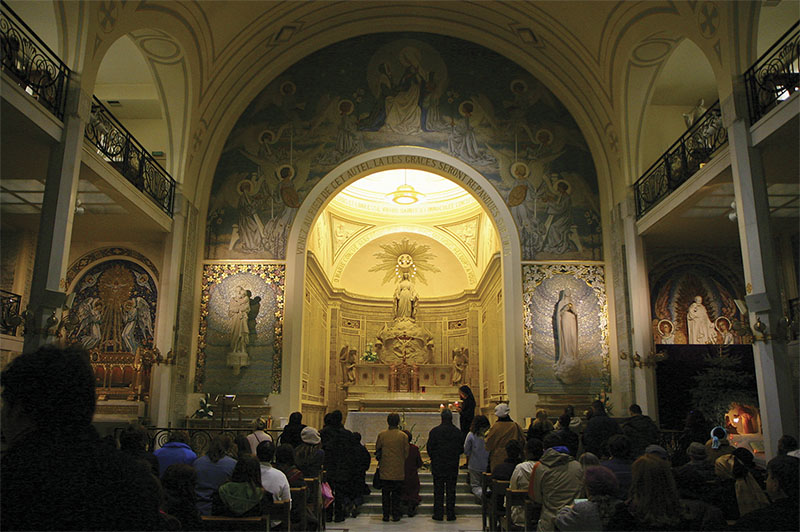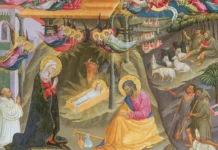Those who visit the Rue du Bac Chapel in Paris, where Our Lady appeared, feel enveloped by an intense feeling of peace, of calm and open skies, as if there were no obstacles between earth and blessed eternity.
The apparitions of the Blessed Virgin to St. Catherine Labouré took place in 1830. The most important of them was on November 27, when Mary revealed the treasure of heavenly gifts destined for the world with the spreading of the Miraculous Medal.
We must remember that, at that time, along with a great resurgence of the practice of the Catholic Faith, there were also strong manifestations of laicism and atheism hostile to the Church, so that an abysmal gulf separated Catholicism from anti-clericalism. I myself experienced echoes of this animosity in Brazil in the 1920s, almost a century after the apparitions of Rue du Bac.
So deep was this valley dividing Church affairs and those of civil society that, when one crossed the threshold between the secular environment and the religious domain, it was like leaving one country and entering another. I remember exiting the Church of the Sacred Heart of Jesus after attending a benediction of the Blessed Sacrament, and noticing the building which was then the Salesian boarding school,1 divided into two wings and occupying the entire block.
The windows of the lower floors were closed and protected by gratings, unlike those of the upper floors. Through these, some bluish lights could be seen on the side where I knew the boys’ dormitory was located – a sign that the children were already asleep. And the clock of the tower had not yet struck nine o’clock at night…
I remember the impression I felt when I entered secular society – I repeat, in the 1920s – and saw the contrast between the bright lights, agitation and entertainment of that world, and that spacious dormitory, where a great number of students slept.
It gladdened me to see those little blue lights shining while everyone was fast asleep, symbolizing the Church’s maternal care, enveloping her children in a comforting glow. With the vigilance of a mother who smiles but does not close her eyes, she is always aware of what is happening. All this gave me the impression of an austerity, sacrality, and order in that ambience which the world outside did not know. It was another universe.
Well, it was in an atmosphere similar to this one that the revelations of Our Lady to St. Catherine Labouré took place in Paris in 1830.
A modest, pure and elevated ambience
She was a nun of the Congregation of the Daughters of Charity founded by St. Louise de Marillac and St. Vincent de Paul. These religious have always distinguished themselves for their exceptional and selfless Christian zeal, dedicating themselves to the care of the poor, orphans and the sick in hospitals and Houses of Mercy. Until recently, they were known for their characteristic habit: a dark tunic with a starched white collar, the head adorned by a Breton cap, stylized by the inspiration and hands of the Church. This head-covering unfolded into two wide flaps, vaguely resembling the wings of a seagull in flight. At the waist hung a large rosary, as is natural in religious habits.
I did not have regular contact with these nuns, but I have met many of them. In general, they were robust, strong and ready for work. They had a clear, honest gaze, and the unpretentious attitude of someone who prefers to pass unnoticed. They carried out temporal works of mercy as an opportunity for spiritual works of mercy.
So great was the importance of this apostolate of the Sisters of Charity of St. Vincent de Paul, and they were so admired for it, that they used to be regarded as the very symbol of religion in one of its most beautiful and moving expressions.
Their main convent is located in an historic and aristocratic district of the French capital, Faubourg Saint-Germain, and has become known by the name of the street on which it was built: Rue du Bac.
We should picture in our minds the city of Paris in the 1830s, much smaller and less populated than it is today – quiet and tranquil, without the noise of engines and neon lights. We can imagine the cobblestone streets on which the echo of a horse’s hooves or the wheels of a carriage interrupted the long silence of the night. In the dormitory of the nuns of St. Vincent, there were no little blue lights, but perhaps some lamps lit. All the nuns were sleeping, including St. Catherine Labouré.
In this modest, pure and sublime ambience, completely different from the outside world, a supernatural marvel is beginning to unfold.
Colloquies with the Queen of Heaven

The first apparition took place on July 18, 1830, as if prompted by the seer’s beautifully childlike, innocent and filial attitude. The day before, she had heard an exposition on devotion to Our Lady, and felt an ardent desire to see Her. She went to bed with the feeling that she would meet the Blessed Virgin that very night.
That is exactly what happened. As St. Catherine Labouré herself tells us, at about half past eleven, she hears someone call her. She draws the curtain of her bed and sees a boy of four or five who says to her: “Come to the chapel, the Blessed Virgin awaits you.”
The Saint expresses some concern, fearing lest the other sisters see her out of bed, but the child reassures her; she gets dressed and begins to follow him through the corridors of the convent. A curious detail was recorded by the seer, who was greatly amazed by the fact: wherever they passed, the lamps were lit.
She enters the chapel and her surprise is even greater when she notices all the lighted candles in the candelabras, as if in preparation for Midnight Mass. The child leads her to the presbytery; next to the chair on which the vicar sits, St. Catherine knelt, while the child remained standing. She was in constant fear that one of the nuns would pass by and find them there, and demand an explanation that she would be unable to give…
Finally, the child announced: “Here is the Blessed Virgin.” The seer heard the soft rustle of a silk dress, but could still not see Our Lady. Then the child insisted – no longer with the voice of a child, but in a vigorous tone – that the Queen of Heaven was present. At that moment, St. Catherine saw the Mother of God come and sit on the vicar’s chair; she sprang toward Her and, kneeling, placed her folded hands on Mary’s lap.
A marvellous scene unfolded, an apparition marked by extraordinary affability. Thus, it is understandable that St. Catherine recorded this moment as the sweetest of her life, impossible to be expressed in words. There she received various counsels and instructions from Our Lady, which she preferred to keep secret.
The Miraculous Medal
We can well imagine how St. Catherine felt after this meeting with Our Lady, and how her heart must have beat with an intense desire to see Her again. A few months later, her hopes would be generously fulfilled. The second and most important encounter took place on the afternoon of Saturday, November 27, 1830. This is how a chronicler of the various apparitions of Mary relates it:
“In her chapel at Rue du Bac, the Daughters of Charity – Sisters and novices – gather for evening meditation, in recollection and prayerful silence. Suddenly, in the midst of her pious contemplation, Catherine Labouré thinks she hears the sound of a silk dress sweeping along the floor… The Blessed Virgin is there!
“Any thought is impossible in the face of Mary’s inconceivable beauty. She wears a silken dress as brilliant as the dawn. The veil that falls from her head to her feet is the same colour. She is standing on a large globe, which seems to be fixed in a point of space. Her hands, raised to the level of her chest, gracefully hold another globe, smaller than the pedestal and topped by a cross. The Virgin’s gaze is turned heavenward. Her lips move in prayer. She offers the orb to the Master, her Son.
“Suddenly, the globe disappears and her hands are extended. Her fingers are covered with rings adorned with sparkling gems, which emit dazzling rays in every direction. A thousand precious rays merge into one transcendent radiance. A thousand beams surround the holy figure.
“The Virgin looks down on Catherine in contemplation, overwhelmed by a universe of sensations, sentiments, discoveries, and inexpressible revelations. In the depths of her heart, the novice hears a voice telling her:
“This globe represents the whole world, especially France, and each man in particular.”
The outpouring of rays redoubles in strength and splendour.
“This is the symbol of the graces which I pour out upon those who ask them of me. The stones that emanate no light (This the Blessed Virgin would repeat this on another occasion) symbolize the graces that they forget to ask of me…”2

According to St. Catherine’s account, an oval-shaped frame formed around Our Lady, around which were written in gold letters the following words: “O Mary conceived without sin, pray for us who have recourse to Thee.” Again she heard a voice telling her to have a medal made according to that model, along with the promise: “All those who wear it around their neck will receive great graces, which will abound for those who wear it with confidence.”
Then, says the seer, the picture seemed to revolve and she saw the other side of the medal: in the centre, the monogram of the Blessed Virgin, composed by the letter “M” surmounted by a cross, with a bar at its base. Below, were the Hearts of Jesus and Mary, the first crowned with thorns, and the other, pierced by a sword.
It was the design of the Miraculous Medal, as it would be widely known and spread throughout the world, obtaining heavenly graces and blessings for countless people; miracles of a physical nature, such as the healing of illnesses, and those of a spiritual nature: amendment of life and the most unexpected conversions.
Highly merciful designs for the world
I remember, for example, this fact. A lady of the French aristocracy kept in the magnificently decorated principal room of her residence a framed Miraculous Medal, tarnished and damaged in the centre. The visitors she received at home were surprised to see this mounting so clearly displayed in that splendid room, amidst such fine objects, and asked her what was the reason for it. The lady answered:
“I keep this medal, because my son was a playboy, and while in a bad place, he was shot. The bullet hit the medal directly, and instead of puncturing it, only damaged it in an inexplicable fashion, as if to authenticate the extraordinary fact, and then fell to the ground. In view of this prodigy, my son converted and today he is a model Catholic. Thus, I desire that my visitors hear of this blessing received from Our Lady and thank Her for it. That is why the medal is here.”
A simply uncountable number of similar episodes in which precious graces have been obtained through the Miraculous Medal explains why it has become the object of so much devotion. Mary Most Holy destined it to be a marvellous means for fulfilling her highly merciful designs for the world.

Expression of Mary’s maternal affection
It is also interesting to point out that this particular protection of the Blessed Virgin in relation to us is very evident in her prerogative as Mother of Divine Grace.
In approaching a statue of this invocation, how many of us have not felt welcomed by a smile from Her, enveloped by a kind of sweetness promising us compassion, pity, and imparting the certainty of being heeded and favoured by an act of inexhaustible goodness?
This is the certainty that Our Lady is always ready to help and support us with her clemency in our material and physical needs, but especially in our spiritual deficiencies, helping us to overcome our defects, temptations and sins. Therefore, Our Lady of Graces could be called Our Lady of Mercy, who will never, never abandon us.
And I believe that this truth can never be emphasised enough: Mother of Divine Grace means the treasurer of all God’s graces. The heavenly gifts are an inexhaustible treasure, placed in the hands of Our Lady and disseminated by Her to those who have recourse to her intercession.
Mary is the dispenser of all graces and also the Mother of those who implore her favours. Mother of the wretched, the afflicted, of those who have almost lost hope, whom She revives, and rekindles in their hearts the flame of Faith.
We need only consider a statue of Our Lady of Graces to understand how much this title expresses Mary’s maternal affection for us. She welcomes us with open arms, a smile on her lips, overflowing with the loving invitation for us to approach and to spend some time with Her. She envelops us with affability and an unfathomable promise of unlimited forgiveness. And She make her gentle voice heard in the depths of our soul: “You have Me, I am entirely yours. And because of this, all the ways to Heaven are open to you…” ◊
Taken, with slight adaptations, from:
Dr. Plinio. Year VIII. N.92 (Nov. 2005); p.18-25
Notes
1 Salesian school adjoined to the Church of the Sacred Heart of Jesus, known as the Lyceum, located in the Campos Elíseos neighbourhood of São Paulo.
2 Cf. MOLAINE, Pierre. L’itinéraire de la Vierge Marie. Paris: Corrêa, 1953.







